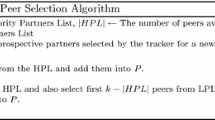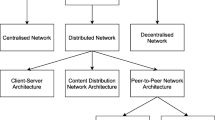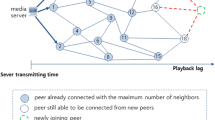Abstract
With the rapid growth of the scale, complexity, and heterogeneity of Peer-to-Peer (P2P) systems, it has become a great challenge to deal with the peer’s network-oblivious traffic and self-organization problems. A potential solution is to deploy servers in appropriate locations. However, due to the unique features and requirements of P2P systems, the traditional placement models cannot yield the desirable service performance. To fill this gap, we propose an efficient server placement model for P2P live streaming systems. Compared to the existing solutions, this model takes the Internet Service Provider (ISP) friendly problem into account and can reduce the cross-network traffic among ISPs. Specifically, we introduce the peers’ contribution into the proposed model, which makes it more suitable for P2P live streaming systems. Moreover, we deploy servers based on the theoretical solution subject to practical data and apply them to practical live streaming applications. The experimental results show that this new model can reduce the amount of cross-network traffic and improve the system efficiency, has a better adaptability to Internet environment, and is more suitable for P2P systems than the traditional placement models.
Similar content being viewed by others
References
Pable R, See-Mong T, Christos G (2006) On the feasibility of commercial, legal P2P content distribution. Comput Commun Rev 36(1):75–78
Haiyong Y, Richard Y, Arvind K, Yanbin GL, Abraham S (2008) P4P: provider portal for applications. Comput Commun Rev 38(4):351–362
David RC, Fabian EB (2008) Taming the torrent: a practical approach to reducing cross-ISP traffic in peer-to-peer systems. Comput Commun Rev 38(4):363–374
Osama S, Hohamed H (2008) Traffic modeling and proportional partial caching for peer-to-peer systems. ACM Trans Netw 16(6):1447–1460 ISSN:1063-6692
Moses C, Sudipto G, Eva T, David BS (1999) A constant-factor approximation algorithm for the k-median problem. In: Proc ann ACM symp theory of computing, pp 1–10
Vijay VV Approximation algorithms for metric facility location and k-median problems using the primal-dual schema and Lagrangian relaxation, Journal of the ACM 274–296 (1999). ISSN:0004-5411, EISSN:1557-735X
Craig W, Steven HL, David XW (2002) High-density model for server allocation and placement. ACM SIGMETRICS 30(1):152–159
Martin P, Eva T, Tom W Facility location with nonuniform hard capacities. In: Proc IEEE symp foundations of computer science, pp 329–338
Osama S, Hohamed H (2006) Modeling and caching of peer-to-peer traffic. In: Proc. IEEE international conference on network protocols, pp 249–258
Fabian AC, David PW (1999) Improved approximation algorithms for the capacitated facility location problem. In: Proc. Ann. ACMSIAM symp. discrete algorithms, pp 207–222
Dorit SH (2005) Heuristics for the fixed cost median problem. Math Program 22(1):207–222. doi:10.1007/BF01581035
Mihai B, Sariel H, Piotr I (2002) Approximate clustering via core-sets. In: Proc 34th annu ACM sympos theory of computing, pp 250–257
Lili Q, Venkata NP, Geoffrey MV (2002) On the placement of web server replicas. In: Proc IEEE INFOCOM, pp 1587–1596
Retsef L, David BS (2004) LP-based approximation algorithms for capacitated facility location. In: Proc ann. ACM-SIAM symp discrete algorithms, pp 206–218
Eric C, Sugih J, Cheng J, Danny R, Anthony RK, Yuval S (2001) Constrained mirror placement on the Internet. In: Proc IEEE INFOCOM, vol 1, pp 31–40
Hao Y, Xueling L, Tongyu Z et al (2009) Design and deployment of a hybrid CDN-P2P system for live video streaming: experiences with LiveSky. In: Proc ACM, pp 25–34
Allen D Using pathchar to estimate Internet link characteristics. ACM SIGCOMM, Comput Commun Rev 27(1) (1999)
Kuan-Ta C, Chun-Ying H, Polly H, Chin-Laung L (2006) Quantifying skype user satisfaction. In: Proc SIGCOMM
Tom L (2008) Improving performance on the Internet. ACM Queue 6(6):20–29. ISSN:1542-7730 EISSN:1542-7749
Statistical Survey Report on The Internet Development in China, Publishing PhysicsWeb. http://www.cnnic.net.cn/en/index/0O/02/index.htm. Accessed 18 Nov. 2010
Silvano M, Paolo T (1990) Knapsack problems: algorithms and computer implenentations. Wiley-Interscience series in discrete mathematics and optimization. Wiley, New York
Jiangchuan L, Sanjay GR, Bo L, Hui Z (2008) Opportunities and challenges of peer-to-peer Internet video broadcast. In: Proc. IEEE Special issue on recent advances in distributed multimedia communications, vol 96, pp 11–24
Bo L, Susu X, Keung GY, Jiangchuan L, Stoica I, Hui Z, Xinyan Z (2007) An empirical study of the CoolStreaming system. IEEE J Sel Areas Commun 25(9):1627–1639 ISSN: 0733-8716
Author information
Authors and Affiliations
Corresponding author
Rights and permissions
About this article
Cite this article
Yuan, X., Yin, H., Min, G. et al. A suitable server placement for peer-to-peer live streaming. J Supercomput 64, 1092–1107 (2013). https://doi.org/10.1007/s11227-011-0685-2
Published:
Issue Date:
DOI: https://doi.org/10.1007/s11227-011-0685-2




